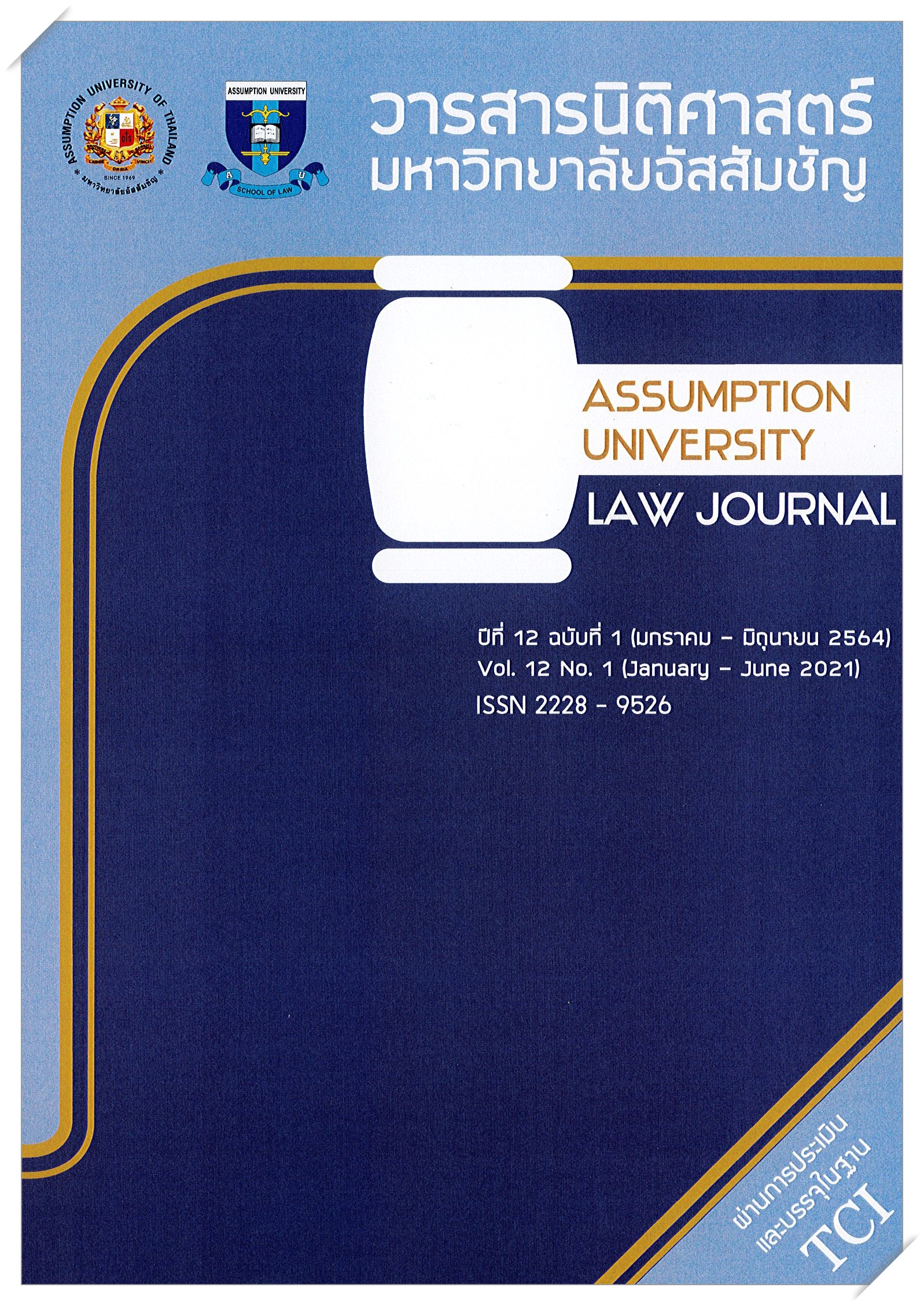ประเด็นกฎหมายเกี่ยวกับการรวมกลุ่มทางเศรษฐกิจและอาเซียน
Legal Issues Concerning the Economic Integration and ASEAN
Keywords:
การรวมกลุ่มทางเศรษฐกิจในระดับภูมิภาค, Regional trading arrangements or RTAs, ความตกลงทั่วไปว่าด้วยอัตราภาษีศุลกากร, General Agreement on Tariffs and Trade หรือ GATT, การค้าชายแดน, frontier traffics, เขตเศรษฐกิจพิเศษ, special economic, กฎบัตร อาเซียน, ASEAN Charter, USAAssumption University Law Journal, วารสารนิติศาสตร์ มหาวิทยาลัยอัสสัมชัญ, Association of South East Asian Nations, ASEAN, Special economic zones (SEZs), Vol. 12 No. 1 (January - June 2021), ปีที่ 12 ฉบับที่ 1 (มกราคม - มิถุนายน 2564)Abstract
บทคัดย่อ
ในปัจจุบัน การรวมกลุ่มทางเศรษฐกิจในระดับภูมิภาค (regional trading arrangements หรือ RTAs) ได้ทวีจำนวน (proliferation) ขึ้นอย่างมากนับพันๆ แห่ง และไม่จำกัดอยู่ในภูมิภาคเดียวกัน (same region) แต่ขยายตัวข้ามภูมิภาค (cross regions) รวมทั้งมีการรวมกลุ่มทางเศรษฐกิจในลักษณะสองฝ่าย (bilateral trading arrangements) อย่างไรก็ดี เมื่อพิจารณากฎเกณฑ์ของการรวมกลุ่มทางเศรษฐกิจตามความตกลงทั่วไปว่าด้วยอัตราภาษีศุลกากร (General Agreement on Tariffs and Trade หรือ GATT) พบว่า RTAs เหล่านี้ ไม่สอดคล้องกับหลักเกณฑ์ดังกล่าว สภาวะเช่นนี้ จึงอาจก่อให้เกิดปัญหากับการค้าเสรี (free trade) ในระดับโลก เพราะ RTAs เป็นข้อยกเว้นของหลักการห้ามไม่ให้เลือกปฏิบัติ (most favoured nation reatment หรือ MFN) ดังนั้น ยิ่งมี RTAs เพิ่มขึ้นมากเท่าไร การเลือกปฏิบัติก็ยิ่งมีมากขึ้นเท่านั้น อาเซียน (ASEAN) อยู่ในสภาวะนี้และได้รับ ผลกระทบเช่นเดียวกัน อนึ่ง RTAs มีหลายประเภท เช่น เขตการค้าเสรี (free trade areas หรือ FTAs) สหภาพศุลกากร (customs unions หรือ CUs) และประชาคมเศรษฐกิจ (economic communities หรือ ECs) นอกจากนี้ ยังมีเขตเศรษฐกิจ (economic areas) ซึ่งคล้ายแต่ไม่ใช่ RTAs เช่น การค้าชายแดน (frontier traffics) และเขตเศรษฐกิจพิเศษ (special economic zones หรือ SEZs) ซึ่งทำเกิดความสับสน นอกจากนี้ การอนุวัตการ (implementation) ให้เป็นไปตามสิ่งต่างๆ เหล่านี้ เกือบทุกประเทศ รวมทั้งประเทศไทย จำเป็นต้องมีกฎหมายอนุวัติการด้วย
ดังนั้น บทความนี้จึงจะพยายามที่จะอธิบายถึงประเด็นกฎหมายดังกล่าวข้างต้นอย่างสั้นและกระชับที่สุด เพื่อให้ผู้อ่านสามารถเข้าใจได้ในระดับต้น
Abstract
At present, regional trading arrangements or RTAs have been proliferated to a number of thousands, and they are not circumscribed within the same regions but are expanded cross-regions. Some RTAs are in a form of bilateral trading agreements. However, appraising from the criteria established by the General Agreement on Tariffs and Trade (GATT), it appears that most of these RTAs are not in agreement with the criteria. These phenomena pose a problem to free trade on a global basis because the RTAs are an exception to the principle of the most favoured nation treatment or MFN. Consequently, the more the world has RTAs the more free trade on a global basis shall be thereby affected. The ASEAN which is a multilateral RTA shall be similarly affected. Moreover, there are many types of RTAs, such as free trade areas or FTAs; customs unions or CUs; and economic communities or ECs. In addition, there are economic areas which are similar to but not the same as RTAs, such as frontier traffics and special economic zones or SEZs, which create confusion. Besides, in the implementation of
these things, virtually all states involved, including Thailand, shall need implementing legislations.
Accordingly, this paper shall endeavour to explain the legal issues associated with these things in a concise manner for readers to preliminary understand them.
Downloads
Published
Issue
Section
License
- บทความทุกเรื่องได้รับการตรวจทางวิชาการโดยผู้ทรงคุณวุฒิ (Reader) จากภายในและนอกมหาวิทยาลัย
- ความคิดเห็นใดๆ ที่ลงตีพิมพ์ในวารสารกฎหมายคณะนิติศาสตร์ มหาวิทยาลัยอัสสัมชัญ เป็นของผู้เขียน (ความคิดเห็นใดๆ ของผู้เขียน กองบรรณาธิการวารสารกฎหมายคณะนิติศาสตร์ มหาวิทยาลัยอัสสัมชัญไม่จำเป็นต้องเห็นด้วย)
- กองบรรณาธิการวารสารกฎหมายคณะนิติศาสตร์ มหาวิทยาลัยอัสสัมชัญ ไม่สงวนสิทธิในการคัดลอก แต่ให้อ้างอิงแสดงแหล่งที่มาด้วย


